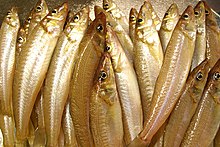| Sillaginidae | |
|---|---|

| |
| Sillago japonica | |
| Scientific classification | |
| Domain: | Eukaryota |
| Kingdom: | Animalia |
| Phylum: | Chordata |
| Class: | Actinopterygii |
| Order: | Spariformes |
| Family: | Sillaginidae Richardson, 1846 |
| Type genus | |
| Sillago Cuvier, 1817
| |
| Genera | |
|
Sillaginodes | |
The Sillaginidae, commonly known as the smelt-whitings, whitings, sillaginids, sand borers and sand-smelts, are a family of benthic coastal marine fish historically classified in the order Perciformes, although the 5th edition of Fishes of the World places the family in the Spariformes.[1] The smelt-whitings inhabit a wide region covering much of the Indo-Pacific, from the west coast of Africa east to Japan and south to Australia. The family comprises only five genera and 35 species, of which a number are dubious, with the last major revision of the family in 1992 unable to confirm the validity of a number of species. They are elongated, slightly compressed fish, often light brown to silver in colour, with a variety of markings and patterns on their upper bodies. The Sillaginidae are not related to a number of fishes commonly called 'whiting' in the Northern Hemisphere, including the fish originally called whiting, Merlangius merlangus.
The smelt-whitings are mostly inshore fishes that inhabit sandy, silty, and muddy substrates on both low- and high-energy environments ranging from protected tidal flats and estuaries to surf zones. A few species predominantly live offshore on deep sand shoals and reefs, although the larvae and juvenile phases of most species return to inshore grounds, where they spend the first few years of their lives. Smelt-whitings are benthic carnivores that prey predominantly on polychaetes, a variety of crustaceans, molluscs, and to a lesser extent echinoderms and fish, feeding by detecting vibrations emitted by their prey.
The family is highly important to fisheries throughout the Indo-Pacific, with species such as the northern whiting, Japanese whiting, and King George whiting forming the basis of major fisheries throughout their range. Many species are also of major importance to small subsistence fisheries, while others are little more than occasional bycatch. Smelt-whitings are caught by a number of methods, including trawling, seine nets, and cast nets. In Australia and Japan in particular, members of the family are often highly sought by recreational fishermen who also seek the fish for their prized flesh.
- ^ Nelson, J.S.; Grande, T.C.; Wilson, M.V.H. (2016). Fishes of the World (5th ed.). Hoboken, NJ: John Wiley & Sons. pp. 502–506. doi:10.1002/9781119174844. ISBN 978-1-118-34233-6. LCCN 2015037522. OCLC 951899884. OL 25909650M.